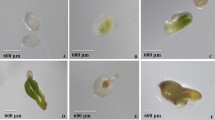Abstract
The embryo rescue technique was successfully used to raise hybrids between Trifolium alexandrinum and T. constantinopolitanum. As a result of its narrow genetic base, genetic improvement in Egyptian clover (syn. Berseem; T. alexandrinum), an important fodder crop in tropical and subtropical countries, is hampered, thereby making it imperative to introduce alien genes from related species. In a conventional interspecific hybridization program, hybrids could not be raised due to post-fertilization barriers. Of the several combinations tried, pollination 2 days after emasculation was found to be the best. Globular embryos were observed 5–7 days after pollination (DAP), followed by heart-shaped embryos 10–12 DAP. Embryos excised at the heart-shaped stage responded well to EC3 culture medium. Of 612 crosses, 33 healthy embryos could be excised and cultured on EC3 medium. The plumule emerged 8–12 days following inoculation. The embryo-rescued plants were hardened, inoculated with Rhizobium and transferred to the field. The hybrids showed intermediate morphological features with reduced pollen fertility (55–65%) and a chromosomal complement of 2n=16. Biochemical characterization using isozymes confirmed hybridity.


Similar content being viewed by others
Abbreviations
- ACP::
-
Acid phosphatase
- IAA::
-
Indole-3-acetic acid
- BA::
-
6-Benzyl adenine
- DAP::
-
Days after pollination
- Est::
-
Esterase
- NAA::
-
α-Naphthaleneacetic acid
- SOD::
-
Superoxide dismutase
References
Brewbaker JL, Keim WF (1953) A fertile interspecific hybrid in Trifolium. Am Nat 87:323–326
Collins GB, Taylor NL, Phillips GC (1981) Successful hybridization of red clover with perennial Trifolium species via embryo rescue. In: Smith TA, Hays VW (eds) Int Grassland Congr Lexington, vol 14. Westview Press, Boulder, Col., pp 168–170
Evans AM (1962) Species hybridization in Trifolium. II. Investigating the prefertilization barriers to compatibility. Euphytica 11:256–262
Ferguson NH, Rupert EA, Evans PT (1990) Interspecific Trifolium hybrids produced by embryo and ovule culture. Crop Sci 30:1145–1149
Kumar B (2001) Studies on Inter and intra-genetic distance among Trifolium species based on morphological, biochemical and cytogenetical attributes. PhD thesis, Bundelkhand University, Jhansi, India
Murashige T, Skoog F (1962) A revised medium for rapid growth and bioassays with tobacco tissue cultures. Physiol Plant 15:473–497
Pandey K (1957) A self compatible species in Trifolium. J Her 48:278–281
Pandey KK, Grant JE, Williams EG (1987) Interspecific hybridization between Trifolium. Aust J Bot 35:171–182
Phillips GC, Collins GB (1979) In vitro tissue culture of selected legumes and plant regeneration from callus cultures of red clover. Crop Sci 19:59–64
Phillips GC, Collins GB (1984) Red clover and other forage legumes. In: Sharp WR, Evans DA, Ammirato PV, Yamada Y (eds) Handbook of plant cell culture, vol 2. Macmillan, New York, pp 169–210
Phillips GC, Collins GB, Taylor NL (1982) Interspecific hybridization of red clover (Trifolium pratense) with T. sarosiene using in vitro embryo rescue. Theor Appl Genet 62:17–24
Phillips GC, Grosser JW, Berger S, Taylor NL, Collins GB (1992) Interspecific hybridization between red clover and Trifolium alpestre using in vitro embryo rescue. Crop Sci 32:1113–1115
Poulik MD (1957) Starch gel electrophoresis in a discontinuous system of buffers. Nature 180:1477–1479
Przywara L, White DWR, Sanders PM, Maher D (1989) Interspecific hybridization of Trifolium repens with T. hybridum using in ovule embryo and embryo culture. Ann Bot 64:613–642
Sawai A, Ueda S, Gau M, Uchiyama K (1990) Interspecific hybrids of Trifolium medium L. × 4x T. pratense L. obtained through embryo culture. J Jpn Soc Grassland Sci 35:267–272
Sawai A, Yamaguchi H, Uchiyama K (1995) Fertility and morphology of the chromosome-doubled hybrid Trifolium medium × T. pratense (red clover) and backcross progeny. Grassland Sci 41:122–127
Selim AK, Abdel-Tawab FM, Fahmy EM (1977) Phylogenetic relationship in genus Trifolium L. I. Interspecific crossability and serological affinities. Egypt J Genet Cytol 6:274–283
Smithies O (1955) Zone electrophoresis in starch gel: group variation in the serum proteins of normal human adults. Biochem J 61:629–641
Taylor NL (1959) An interspecific hybrid involving red clover. Agron Abstr 67–68
Trimble JP, Hovin AW (1960) Interspecific hybridization of certain Trifolium species. Agron J 52:405
Veech JA (1969) Localization of peroxidase in infected tobaccos susceptible and resistant to black shank. Phytopathology 59:556–571
Wendel JF, Weeden NF (1989) Visualization and interpretation of plant isozymes. In: Soltis DS, Soltis PS (eds) Isozymes in plant biology. Chapman and Hall, London, pp 5–45
Wexelsen H (1928) Chromosome numbers and morphology in Trifolium. Calif Univ Agric Sci 2:355–376
Williams E, Verry IM (1981) A partially fertile hybrid between Trifolium repens and T. ambiguum. N Z J Bot 19:1–7
Williams E, White DWR (1976) Early seed development after crossing of Trifolium ambiguum and T. repens. In: Proc 3rd Int Congr SABRAO, vol 2, pp 26–30
Yamada T, Fukuoka H (1986) Production of interspecific hybrids between Trifolium ambiguum M. Bieb. and T. repens L. by ovule culture. Jpn J Breed 36:233–239
Zohary M (1972) Origins and evolution in the genus Trifolium. Bot Not 125:501–511
Zohary M, Heller D (1984) The genus Trifolium. The Israel Academy of Sciences and Humanities, Jerusalem
Acknowledgements
The authors are grateful to the Director of the institute and Head, Crop Improvement Division for use of the facilities and his encouragement. Financial support from the Indian Council of Agricultural Research (project AP CESS) is also acknowledged.
Author information
Authors and Affiliations
Corresponding author
Additional information
Communicated by P.P. Kumar
Rights and permissions
About this article
Cite this article
Roy, A.K., Malaviya, D.R., Kaushal, P. et al. Interspecific hybridization of Trifolium alexandrinum with T. constantinopolitanum using embryo rescue. Plant Cell Rep 22, 705–710 (2004). https://doi.org/10.1007/s00299-004-0759-1
Received:
Revised:
Accepted:
Published:
Issue Date:
DOI: https://doi.org/10.1007/s00299-004-0759-1




